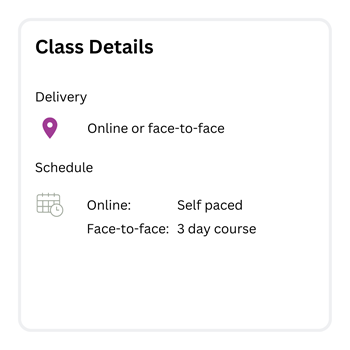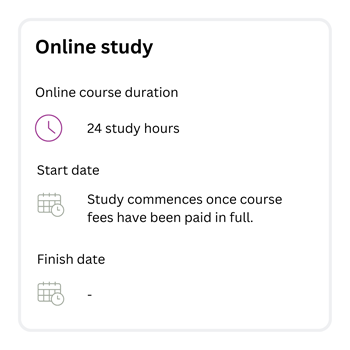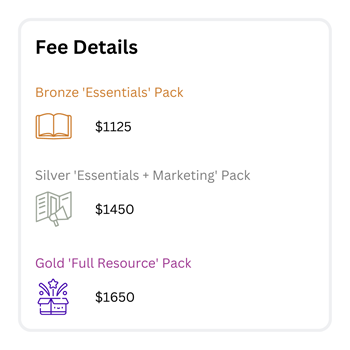
.png?lang=en-AU&width=198&height=61)





What time classes run:
Online study:
You have the flexibility to study at your own pace, without any strict deadlines or fixed completion date. Your enrolment will remain valid for as long as you need to finish the course successfully. Once you begin your studies, you will receive a suggested training guideline that outlines a simple step-by-step process leading to certification. With no set login times, you can access the course whenever it suits you best.
Face to face study:
Join us for face-to-face training sessions held on Fridays, Saturdays, and Sundays from 9am to 5pm each day. To find out the exact dates and locations of upcoming training sessions, please refer to the training dates and locations page.
Other Things To Know:
Assessments:
Assessments within the course offer a chance to showcase your learning, while allowing the trainer to log and evaluate your competencies. They also serve to address any misunderstandings and provide additional assistance with practical demonstrations if needed.
The assessment comprises three tasks, designed to be straightforward and easily completed. Throughout the course, you have the option to receive personalised help and clarification for any questions you may have.
Online student assessment:
The theory assessment consists of an open-book, multiple-choice exam based on the training manual. You will need to complete the provided answer sheet and submit it via email for grading. This task ensures that you have thoroughly read and understood the training manual, are well-acquainted with the content and know how to refer back to the information when necessary.
For the practical tasks, you can use your preferred recording device, with most students opting to use their smartphones. The initial practical task involves conducting a massage demonstration on your demonstration doll. You will receive a list of techniques that you need to demonstrate to ensure that the trainers get to see you perform the same demonstrations they see when they work with students attending the in-person course. The feedback you receive will be highly detailed, with each technique broken down into various components on the marking template. This level of precision ensures that if any technique is performed incorrectly, you will not only be informed about the specific technique that needs improvement but also the aspect of that technique that requires some attention. Providing such precise feedback has proven to be very effective, as online students achieve excellent results and show a high level of confidence in their massage demonstrations.
The final practical task for online students involves a practice teaching session. You can either conduct this session with a volunteer parent and infant or perform it as a role play task with a friend or family member (playing the role of a parent you are teaching baby massage to). For this task, you will receive a specific list of massage demonstrations and theory topics to cover. These include teaching the parent which oil to use, when to massage and how to recognise and respond to their baby's body language cues during massage. Similar to previous practical task, this session will be recorded using your preferred device, with most students using their smartphones. Instructions on how to upload the footage for trainers to review and provide feedback will be provided. The practical report will be incredibly detailed, allowing trainers to help you identify areas for improvement, offer helpful suggestions for the future and ensure that all required demonstrations and theory content have been adequately covered.
According to student feedback, this practical task is highly beneficial for solidifying the learned content, putting knowledge and skills into practical use, and instilling confidence in your ability to use your Infant Massage Instructor qualification immediately after the course.after completing the course.
Face-to-face student assessment:
The theory assessment involves an open-book, multiple-choice exam based on the training manual. You'll receive an answer sheet to work on after class each day or during break times. On the final day, the class collaboratively marks the answer sheets, fostering group learning and revision. This process ensures any doubts or questions are clarified and the trainer can offer further insights as necessary. Consequently, you will know your assessment results on Sunday, before leaving the course.
Practical tasks are conducted during class time and involve a demonstration of massage techniques on a demonstration doll, as well as a practice teaching session with volunteer parents and infants or role play tasks.
By completing these practical requirements during class, you benefit from real-time feedback, corrections and guidance from your trainer, instilling confidence in your ability to use your Infant Massage Instructor qualification immediately after the course.
Materials needed:
To complete this course, the following materials are required:
- Baby massage demonstration doll
- Infant Massage Training Manual for the Certificate in Infant Massage Instruction and Paediatric Massage Consultancy
- Access to video demonstrations of baby massage techniques
Payment of course fees must be made in full prior to commencement of study.
Entry requirements:
The Certificate in Infant Massage Instruction has no prerequisites or prior training requirements. To enrol in the course, students need to provide their full name, postal address, phone number, and email address.
Units taught in this course:
The course is made up of nine core units.
- Methodology
- Practical infant massage techniques
- Formal theory
- Altering techniques for special circumstances
- Respecting children as people
- Considering the parents
- How to utilise your qualification
- Awareness and adaptations
- Technicalities
For a comprehensive list of the content covered in each unit, please see the
course content page.
Studying online:
With online study, you have the freedom to learn at your convenience and set your own learning pace. Upon enrollment, you will receive a suggested training plan tailored to this course, which will include a helpful study guide. As the course is self-paced, there is no pressure and no set deadlines you need to meet. You can complete the course at a relaxed pace, taking as much time as you need. Any amount of time you require will be okay.
There are no set times you need to login or be online, granting you the flexibility to access the course materials and complete coursework whenever it suits your schedule best. This allows you to accommodate other commitments and responsibilities in your life while completing your baby massage course. Whether you choose to dedicate an hour each day or spread your study over a longer period, the choice is entirely up to you.
During your learning journey, if you ever need support or have questions, simply reach out for assistance and the course instructors will be there to help you. When you feel prepared to demonstrate your understanding, you can submit your assessment tasks at your own pace, whenever you're ready.
Many students find this level of flexibility to be one of the key advantages of online learning. It ensures that you can balance your personal and professional life while gaining valuable knowledge and skills through the baby massage course. It's worth noting that while a significant number of students typically finish the course within three weeks, the self-paced nature of the course allows you to progress comfortably and confidently according to your unique circumstances.
Student support:
As an enrolled student with the Infant Massage Information Service (IMIS), you have access to comprehensive support services to enhance your learning experience. Even after completing the course, we encourage you to stay in touch for ongoing support while utilising your baby massage qualification. You'll never be left on your own.
At IMIS, we are here to assist you whether you are currently enrolled, planning to enroll, or have already completed the course and need follow-up guidance.
Our support services extend to various groups, including:
- Aboriginal and Torres Strait Islander students
- Students with permanent or temporary disabilities
- Individuals from multicultural backgrounds studying with IMIS
- Students facing challenges with learning and study skills
Additionally, we offer information, support, and training options for students residing overseas.
Play a crucial role in fostering the healthy development of infants, creating lasting bonds between parents and their babies.

The training was great! The trainer was so kind and patient. She was incredibly knowledgable and made the course very interesting. I'm looking forward to supporting parents and encouraging parent/child bonding. This is so beneficial for parents and babies, the more people who know about it, the better.

Paula answered all my queries and met all my expectations. The course was a good balance of theory & prac work.

I recently completed my 3 day face to face training. I Love, love, loved the trainer! This course exceeded my expectations. A lot was covered but it was presented sequentially and at a rate that you're able to digest. The power of doing the course face-to-face and networking with others was amazing. I was happy to hear there are future PD opportunities offered by IMIS and I will take advantage of these.
Our trainer was approachable and full of knowledge. The way she paced and structured the course was perfect. There was a good combination of theory and practical and I'm happy to recommend and endorse the course to others.
With my new Infant and Paediatric massage qualification, I'm looking forward to linking with services to support mothers with PND (community mental health services / inpatient and special units / services).

Very flexible, allowing you to complete the course on your own time. Overall, the course has been really interesting and I'm looking forward to commencing my adventure in teaching parents about baby massage.
Request a brochure